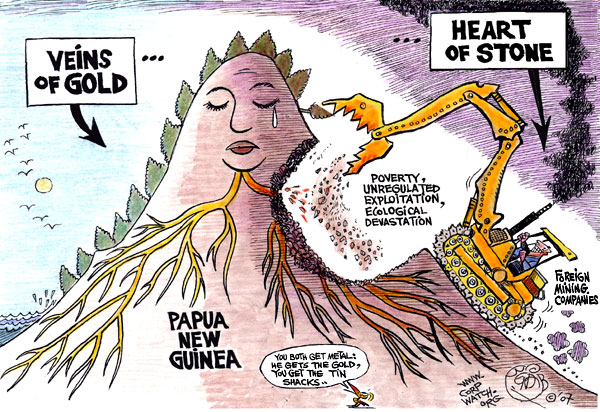
Sakura Saunders
This new video is adapted from speech from Barrick Gold's founder and chairman, Peter Munk, at the company's shareholder's meeting on 28 April 2010 IndyMedia has added the photos from Barrick's operations around the world to "expose the delusional and misleading nature" of Munk's words.
Papua New Guinea: Several photos from this video come from Barrick's Porgera mine in PNG, where several villages rest on a man-made island literally surrounded by an open pit gold mine and its expanding waste dumps. Villagers are seeking resettlement away from the mine site, where mine waste is dumped directly into the river system and mine security have been accused of shooting and killing locals for "trespassing." In 2009, the Norwegian Pension Fund divested $200 million from Barrick Gold due to the riverine tailings disposal in PNG.
In 2009, Barrick housed police who – based on situation reports from Barrick Gold – burnt down an entire hillside of houses adjacent to their Porgera Mine. Barrick initially denied these allegations, remarking that it was their understanding that 50 temporary shacks were tore down. But, a follow-up Amnesty International report showed evidence of at least 130 permanent houses burnt down, while villagers were beaten, harassed, and detained.
Tanzania: In addition to regular confrontations between mine security and locals, often ending in death, Barrick's North Mara mine in Tanzania has had life-threatening pollution to which Barrick has responded with cover-ups and lies.
There have been two reports confirming lasting negative effects of a toxic spill in Tanzania that occurred last May. The latest report, commissioned by an interfaith committee in Tanzania and written by scientists from Norwegian University if Life Sciences and the University of Dar es Salam, found potential life threatening levels of arsenic around Barrick’s North Mara mine in Tanzania. The study investigated the area around the tailing dam and the site of an accidental spill that occurred on May 9, 2009. Despite that fact that these areas were tested four to seven months after the spill, this study shows that the water remains toxic for human consumption and grazing use.
According to Evans Rubara of the Christian Council of Tanzania, "Following the spill in May, 203 people became ill, 43 people died, and 1358 livestock died according to the Ward authorities in North Mara.” The photos featured of the Barrick responded to the report criticizing the integrity of the science, to which the authors responded with a detailed defense of their methodology.
Other photos from Tanzania include shots from Barrick's Bulyanhulu Mine in northern Tanzania. When that mine was operated by Kahama Mining Corporation, it was the scene of one of the world's most infamous cases of mine-related violence. In August 1996, it is alleged that over fifty artisanal (small-scale) miners were buried alive in a pit by a bulldozer used to construct the mine (photos of the exhumed bodies are in the slide show). The move was seen as a tactic to clear the pits of an estimated 250,000 artisanal miners in the community. The mine was then sold to Barrick Gold in 1999.
Philippines: These photos (as well as many of the photos from Tanzania) were taken by Canada-based Photojournalist Allan Lissner, as part of his "Someone Else's Treasure" Series.
In the Spring of 2006, when Barrick Gold took over Placer Dome, Inc. it inherited a law suit initiated by provincial authorities on the Philippine island of Marinduque, where 27 years of irresponsible mining by Placer Dome (1969-1996) had caused immense damage to the island of Marinduque and its people. Rather than settle the case, compensating Marinduquenos for lost livelihood and funding efforts to rehabilitate the damaged eco-systems, Barrick is waging an expensive and lengthy legal battle to avoid responsibility. Two rivers remain biologically dead from these disasters, and the mine pit has refilled with toxic water due to over a decade of raid.
The San Antonio Pit contains millions of tons of mine waste being held back by failing dams. According to a leaked document from Placer Dome's own environmental consultants, "failure of the dam is a virtual certainty in the near term". When the Philippine government ordered Placer Dome to make the necessary repairs, and clean up the mess from two previous dam failures or face criminal charges, Placer Dome responded by pulling out personnel from the Philippines without a word to anyone.
* Note: Barrick does not mine or have plans to mine in Mindoro, Philippines. These photos, also taken by Allan Lissner, are meant to demonstrate the absurdity of Munk's words, that there is no alternative to mining "development".
The photos in this slide show were provided by the communities impacted by Barrick's operations and journalists who have visited Barrick-impacted areas. If you would like to know more information about any of these photos, contact: protestbarrick@gmail.com
or visit: protestbarrick.net.
The following is a summary of some of the images and their source.



